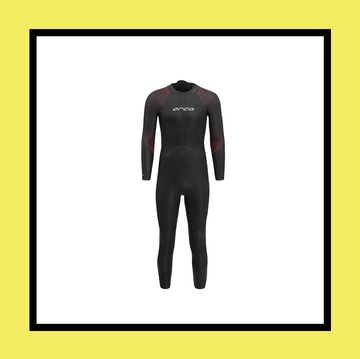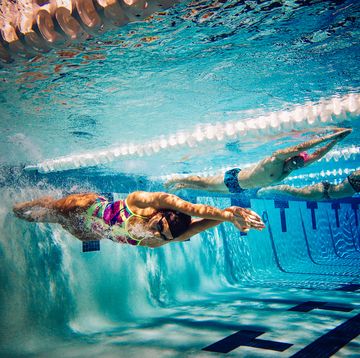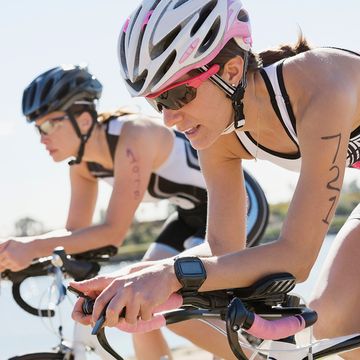Who better to give advice on such matters than a swimming legend, Michael Phelps, winner of six gold medals and three world records at the 2004 Athens Olympics; Terry Laughlin, a swimming guru and founder of Total Immersion (www.totalimmersion.net); and Olympic-coach David Marsh. We gave them a mission to create an easy step-by-step guide to help triathletes with their technique, and they sure came up with the goods.
This guide is triathlon focused and recognises that triathletes, who come in all shapes and abilities, need a different style of training and technique to pro swimmers. For example, Phelps is 6'4" and compared to your penguin-like wing span his 2m one propels him through the water like a nitro-fuelled speedboat. He is also able to put in 45 miles of pool practice a week, which is great for him but you have two other sports
Improve your swim stroke with these expert tips.
However, there are some similarities and Phelps's basic in-pool principle is one that all swimmers and triathletes should learn: "The longer and more streamlined you can make your body, the faster you'll go," he says. "It's that simple."
The advice opposite is aimed towards triathletes of all levels. If you are a beginner, they'll keep you from flailing about like you're being attacked by piranhas. Or if you see yourself as a seasoned veteran, they'll show you how it is possible to shave off the seconds without having to shave your legs.
If you're training for your first triathlon, it's fine to opt for any stroke in the swim but the focus is on freestyle here, not only because it provides a killer cardio workout, but also because it works the most muscles - building core strength and burning calories. Here's our seven-step plan for leaving everyone in your wake.
Olympic-sized advice
1. Swim tall
"Water is 1,000 times denser than air," says Laughlin. "So the single most important factor is to slip your body through the smallest hole in the water." Imagine a central axis extending from the top of your head to the opposite end of the pool. Rotate your body along this axis with each stroke, stretching your leading arm as far forward as you can. Keep the muscles in your lower back and abs taut as you power through the water - doing so will keep the propulsion coming from both your arms and legs.
2. Drop an anchor
Swimming with just your hands is like jumping with just your feet. Instead, grip the water with your entire forearm and hand, holding your forearm at a right angle to your upper arm and digging in like you're gathering sand with a shovel. Keep your hands broad, flat and firm. You're not pushing your arm through the water as much as anchoring it and pulling your body over it.
3. Heavy rotation
Each stroke begins with your leading arm having entered the water, and that side of your body - the low side - pointing almost at the bottom of the pool. The other side of your body - the high side - should be raised, with the arm that just finished its stroke getting ready to return to the water. "Power is triggered when you drive down the high side of your body," Laughlin says. "Throwing your high-side arm forward along the central axis into the leading position and rotating your hips and torso. Meanwhile, your low-side arm is the pulling arm underwater, working with your rotating torso to provide acceleration."
4. Keep your head down
Freestylers used to hold their heads high. That forced the rest of the body to drop, turning it into a high-drag plough. "I look pretty much straight down at the bottom of the pool," says Phelps. "Not only does this cut drag, it keeps your torso high, reducing strain on your neck and lower back."
5. Find your glide path
In the pool, fewer strokes is better. Your goal should be a high distance per stroke (DPS). Elite swimmers like Phelps can easily traverse a 25m pool in seven strokes (each hand entry counts as a stroke). Try to keep yours below 20 by conserving momentum. Pull yourself over your anchor and continue to glide forward with one arm forward and the other back. "You'll travel further and faster with your legs streamlined near your axis," says Laughlin. "When you begin to slow, start the next stroke."
6. Drag your feet
"If you're a good kicker, you're a good swimmer," says Phelps. The secret is turning your feet into fins. Here again, leverage rules: your legs should be taut, scissoring you through the water, while your feet remain flexible. This will help them snap at the downstroke of each kick, adding oomph and helping twist your torso along the central axis. If your feet don't flex well, buy a set of fins (such as Speedo Swim Fins, £19.99) to add flexibility.
7. Don't waste breath
Gasping for air every time your head nears the surface is a great way to drown. Instead, make each breath count. Emphatically exhale the air from your lungs (all of it, not just 90 per cent) before taking a quick, full breath on the high side. Beginning swimmers need to breathe after each stroke, but as your endurance improves, try breathing on alternate sides - that is, after three strokes. It'll reduce the strain on your neck and shoulders that results from always breathing on the same side.
Find Your Racing Form
Your form is great in training but as soon as the gun goes off in a triathlon, you forget how to perform. It's happened to us all: you start to flail your arms, and all you can see when you lift your head is a sea of other triathletes powering away from you. "Swimming fast at the start of a triathlon can sabotage your form, so the challenge is to maintain your efficiency at high intensities," says Laughlin.
Find your threshold
Warm up for five minutes, then do this 500m test. Start at a pace you can hold for more than 500m, but build gradually so that your last 100m is at 90 per cent effort. Count your strokes per length (SPL) in the first and last 100m.
Improve your threshold
Swim 100m repeats for 20 to 30 minutes, resting after each set for a quarter of the time you were swimming. So, if you swam 100m in four minutes, rest for one minute before beginning the next set. Swim at the fastest pace that allows you to keep an SPL count one or two strokes below your count in the final 100m of your test.
Drill bits
Avoid pitfalls with these simple swimming drills from Olympic-coach David Marsh. You'll go from tadpole to torpedo in no time.
Taking a deep breath
Instinct: Advertisement - Continue Reading Below.
The Fix: Imagine your spine as a fixed-axis moving through the water. Keep your head down and roll your shoulders forward with each reach. As your arm extends and you roll to that side, turn your head to sneak a breath.
The Drill: THE CORKSCREW
Swim three strokes of freestyle without breathing; then over-rotate your torso until you're on your back. Take three backstrokes, now roll back into freestyle. Alternate roll sides. Do 10 reps of 50m with 10 seconds of rest after each 50m.
Kick with your core
Instinct: Kicking from the knees disrupts your balance and fatigues your quadriceps muscles - bad news before the bike.
The Fix: Kick from the hips. Small, rhythmic flutters propel you more efficiently than large, flailing kicks, which disengage your hips and thighs. Think of your legs as extensions of your core, bending your knee only slightly.
The Drill: FIN SPRINTS
Wearing foot fins, push off the wall on your back, with your arms stretched above your head. Do a 10 x 50m set; follow each 50m swim with a 30-second recovery period.
Full through
Instinct: You paddle with your hands instead of pulling yourself through the water using your forearms.
The Fix: Anchor your hand, wrist, and forearm as you drive forward into the water. Prevent your elbow from dropping inward as this will only weaken the anchor and your pulling power.
The Drill: CLOSED-FIST SETS
Swimming lengths with closed fists forces you to anchor your forearms. Do a 4 x 50m set of fist-only strokes; rest for 10 seconds after each 50m. Then do a 6 x 50m set with open hands resting for 10 seconds after each 50m.
Build a better workout
Instinct: Health & Injuries.
The Fix: Elite triathletes train by tackling building sets, which begin slowly and end with sprinting. They boost conditioning and create fatigue-proof strokes. Second place goes to the guy whose technique crumbles first.
The Drill: COUNT STROKES
Match the number of strokes on the first, easy length with the final, sprint length. Do a 5 x 100m set at roughly four minute intervals. The first 25m: long and easy. The second: swim at 50 per cent effort. The third: 75 per cent. The final length: 90 per cent.
Personal Services
Whether you're new to triathlon or an experienced racer, swimming is often the discipline that inspires the most trepidation. Most of us are brought up cycling and running but our swimming development may have stopped at school. If you dread the swim, don't despair: there are professionals out there who can analyse your swimming technique, and strengthen your weaknesses even if you're already a good swimmer. And the good news is that there's always room for improvement, as one triathlete discovered recently.
Think you're a pretty good swimmer?
So did I before I visited swimming coaches SWIMFORTRI in London's East End. Okay, so it was 25 years since I'd had a school swimming lesson but I was quick enough to cruise past the pensioners in the slow lane of the pool and keep up with life in the fast lane. I had even tackled the odd 5000m swim-a-thon so when I stepped into an endless pool - which is to swimming what a treadmill is to running - to have my swimming technique scrutinised, I was unprepared for what happened next.
With four cameras trained on my body to film each stroke - two below and two above the water - my instructor Dawn Hunter turned on the current, pressed record on the DVD player and stepped behind a screen to avoid the splashes.
After I'd swum for several minutes, Hunter rewound the DVD and talked me through where I was going wrong - and right. Her feedback did include praise for one or two aspects of my stroke but I was making at least 10 fundamental errors - from kicking from my knees like a scuba diver wearing fins to keeping my arms too straight when pulling them through the water.
There's a limit to how much a trained professional can do for you in one hour but Hunter started me on several drills to improve my kick, timing and the recovery section of the stroke - although not all at once. Hunter was adamant that tackling one drill at a time ensures more rapid improvement than a complete stroke overhaul. By focusing on kicking from the hip instead of the knee, I was swimming at the same pace using less strokes before the hour was over.
I left the session armed with a DVD recording of the before shots as well as a detailed summary of the drills Hunter and I had practised together and some additional suggestions for maximising my swimming potential, including dry-land exercises. It's now a few weeks since my assessment and I'm already learning to kick from my hips, my timing has improved and my bent-arm catch means I'm pulling myself through the water more efficiently. I'm feeling more confident about pitting myself against the current in the Thames at the Windsor Triathlon and I'm definitely more at home in the fast lane of the pool."
- Alison Hamlett
A one-hour swimming assessment with the experts at SWIMFORTRI costs from £60. To find out more about one-to-one coaching, group lessons and customised swimming plans, visit www.swimfortri.com
Tune-up your technique
Visit these websites to find out more about swimming lessons, training sessions and general advice on how to finesse your freestyle:
www.swimtherapy.co.uk
www.swimsquad.co.uk
www.t3performance.co.uk
www.totalimmersion.co.uk
www.goswim.tv
www.pponline.co.uk








